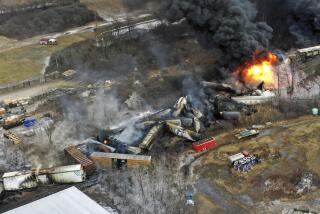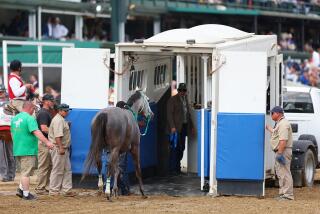Train Accidents’ Forgotten Victims: Conductors, Engineers
- Share via
ALBANY, N.Y. — Rich Nunziato knew they were on a collision course, his train and the car traveling on a road through open fields in southern Quebec.
Still several hundred yards from the ungated crossing, the Amtrak engineer threw the emergency brake and leaned on the whistle. All the time he kept his eye on the approaching car’s front end, looking for but never finding the telltale downward tilt of braking.
An 18-year-old woman died, and Nunziato--who has a daughter about the same age--was badly shaken.
It wasn’t the first time. By his count, he’s been involved in at least 13 car-train fatalities in almost two decades.
Colleagues tell similar tales.
In the first nine months of 1998, according to Federal Railroad Administration statistics, 369 people died in rail trespassing accidents nationwide. In 1997, 553 people were killed.
Though they are seldom injured, engineers and conductors are hurt in other ways. They know it’s coming, hear the crunch, see the gore and wonder: Could they have made a difference?
But, as Nunziato says, “there’s not a damn thing you can do.”
Physics explain why: A train weighing hundreds of tons and moving up to 110 mph on metal rails cannot stop quickly. Even a 150-car freight train traveling at 30 mph needs two-thirds of a mile to stop, according to Operation Lifesaver, a New York state program that promotes safety at rail crossings.
Such numbers are little comfort to a train crew after an accident.
“You feel like a murderer,” says Amtrak conductor Dom Fruci. “You feel responsible.”
After a collision, it’s the engineer’s job to stay with the train, sometimes a mile down the tracks, while the conductor walks back to the site of impact to try to help.
Amtrak stationmaster Jason Cribbs tries to block emotions. “You just want to do your job.”
“You have to get used to the smell,” Fruci says. “There’s a scent to the blood.”
“People don’t know until they actually see it how bad it really is,” he adds.
Conductor Phil Koerner remembers finding a man still conscious despite a bad head injury. He kept repeating, “Help me,” until he died. At another accident site, Koerner found his neighbor had been killed.
Conductor Virginia Rivera encountered a hysterical son holding his decapitated father and blaming the train crew.
For war veterans, the accidents often recall combat, according to Veronica Owens, an employee counselor who set up a peer-support program for train crews at Conrail.
The reaction can be more intense if the victim is a child or resembles a relative. “Some of them will feel like they’re losing it,” she says.
Though they’re usually spared the gore, engineers are often most distressed. “He’s the one at the throttle,” Owens says. “He feels a lot of guilt.”
Now 41, Nunziato tried to handle the first few fatalities on his own. But in 1994 he faced six fatalities in eight months--including three snowmobilers who didn’t hear his whistle and a boy with headphones wandering the tracks.
Nunziato, a 19-year railroad worker from Schodack, N.Y., withdrew from family and friends and began having nightmares. Relief came only after he talked to a counselor.
Owens said engineers and conductors are often hampered by railroader machismo that teaches them to shrug off the accident.
At Amtrak, Koerner and Fruci grew weary of handling the aftermath of accidents on their own. So they started a 24-hour peer emergency response team called CARE. Based at Amtrak’s Rensselaer station, it’s being replicated throughout the company.
Team members have experienced fatal accidents themselves and are trained in handling trauma. They go to the scene to talk to crew members who want to talk. They also provide a link to professional counseling.
Although support systems are valuable, they can’t prevent the accidents. Crews learn to expect the inevitable. Statistics show about half of all crew members will see a fatality within a decade. After two decades, virtually all engineers and conductors are likely to witness a death.
Owens knows of railroad workers who have abandoned the job, unable to answer why the job is worth the potential trauma.
Nunziato, a third-generation railroad man, considered that question recently while his train made its daily run from Albany to New York City.
The train cruised at the 110 mph speed limit with the smoothness that is part of its appeal, and its danger. The icy beauty of the Hudson River flew past his engineer’s perch 15 feet above the track, while the Catskills provided a stately backdrop.
The scenery is part of Nunziato’s job, which most days is mercifully uneventful.
“How could you do anything else, really?” he asks.










